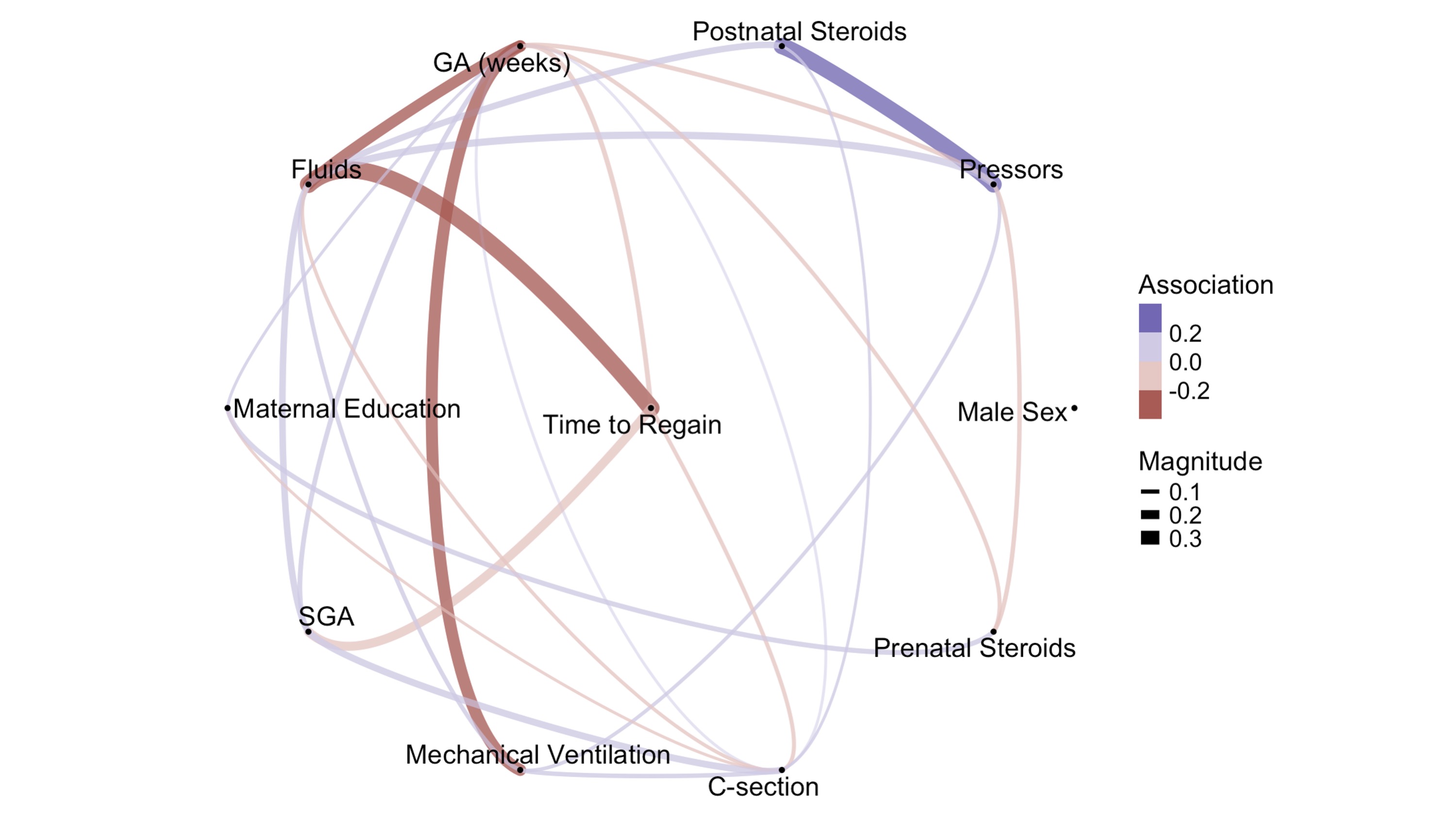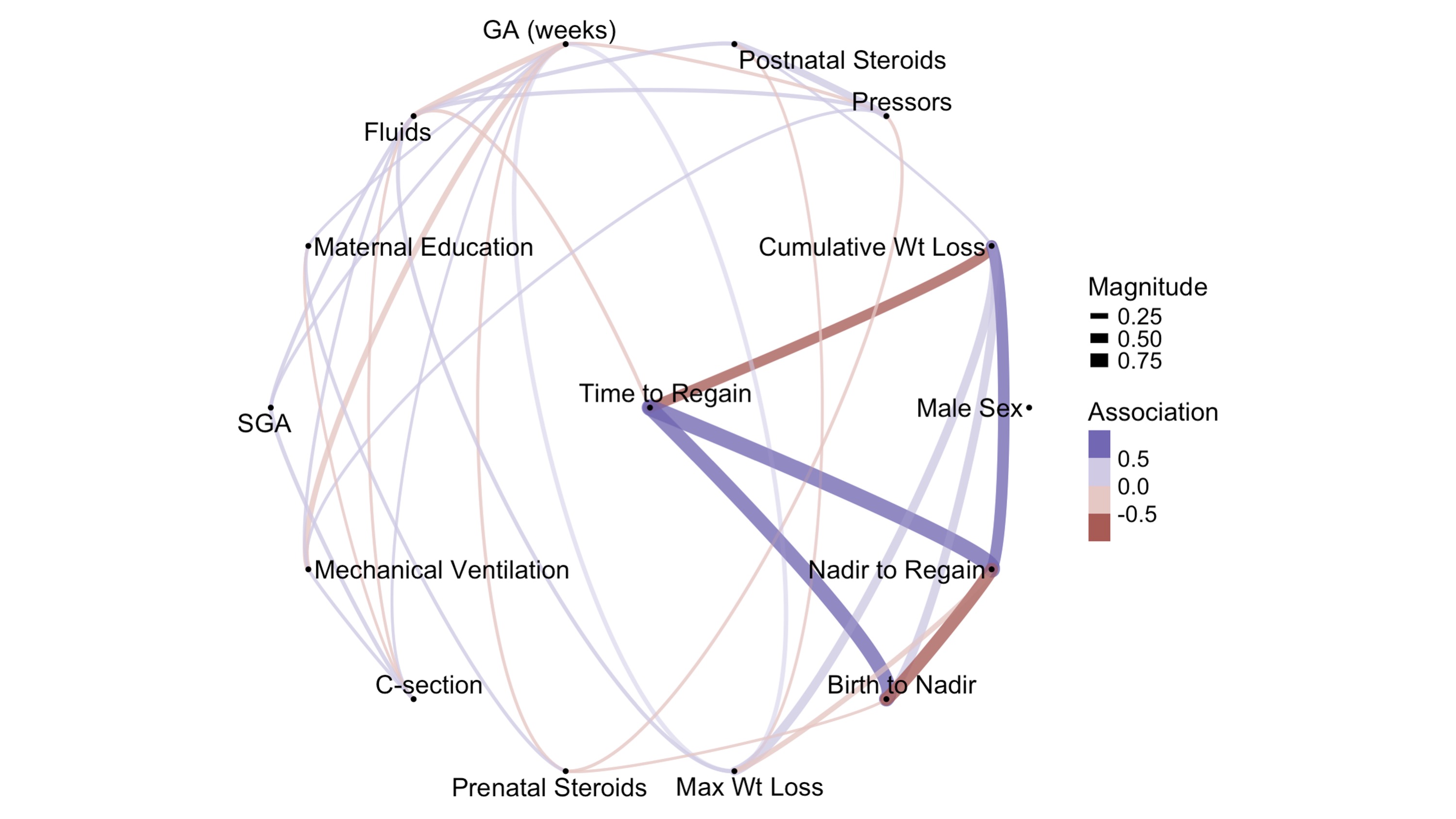Neonatal Fetal Nutrition & Metabolism 2
Session: Neonatal Fetal Nutrition & Metabolism 2
624 - Mediators of Time to Regain Birthweight Among Extremely Preterm Newborns in the United States
Saturday, April 26, 2025
2:30pm - 4:45pm HST
Publication Number: 624.5670
Gregory C.. Valentine, University of Washington School of Medicine, Tacoma, WA, United States; Thomas R. Wood, University of Washington School of Medicine, Seattle, WA, United States; Krystle M.. Perez, University of Washington, Seattle, WA, United States; Olivia C. Brandon, University of Washington: Magnuson Health Sciences Center – RR 544A, Seattle, WA, United States; Dennis E. Mayock, UWMC, Lake Forest Park, WA, United States; Janessa Law, University of Washington and Seattle Children's Hospital, Seattle, WA, United States; Kendell German, University of Washington School of Medicine, Seattle, WA, United States; Sarah E. Kolnik, University of Washington - Seattle Children's Hospital, Seattle, WA, United States; Katie M. Strobel, University of Washington School of Medicine, Seattle, WA, United States; Patrick Heagerty, University of Washington, Seattle, WA, United States; Sandra E. Juul, University of Washington, Seattle, WA, United States

Gregory C. Valentine, MD, MED, FAAP (he/him/his)
Associate Professor of Pediatrics, Division of Neonatology
University of Washington
Seattle, Washington, United States
Presenting Author(s)
Background: National recommendations state that a longer time to regain birthweight (TRB) is a metric of malnutrition in preterm newborns. Conversely, we recently found that a more rapid TRB may be associated with adverse neurodevelopment in extremely preterm (EP, born at < 28 weeks’ gestation) newborns, where the factors that mediate TRB are poorly described.
Objective: To evaluate potential predictors and mediators of TRB among EP newborns.
Design/Methods: Using a prospective database of 876 EP neonates born at 24w0d-27w6d gestation across 30 US neonatal intensive care units enrolled in the Preterm Erythropoietin Neuroprotection (PENUT) Trial, (Table 1), we used graphical network analysis to examine relationships between multiple possible predictors and determinants of TRB. Significant relationships were determined using an inverse covariance matrix and Fisher Z-transformed 95% confidence intervals, with resulting networks showing significant relationships after considering how all the other nodes in the network are inter-related. As such, both direct associations and potential mediation pathways can be explored.
Results: Among n=876 EP newborns, increasing average total fluid administration (TFA) over the first 14 days, decreasing gestational age (GA), cesarean delivery, and small for gestational age (SGA) status were all associated with a shorter TRB (Figure 1). However, when evaluating relationships with the addition of the subcomponents of TRB such as maximum weight loss percentage, time from birth to weight loss nadir, time from nadir to regain of birthweight, and cumulative weight loss, only increasing TFA remained associated with a shorter TRB (Figure 2). Increasing TFA was associated with vasopressor use, postnatal steroids, respiratory distress, and decreasing GA. Increasing GA was associated with decreased TFA, less respiratory distress, and less exposure to vasopressors or antenatal corticosteroids.
Conclusion(s): TRB appears to be predominantly mediated by TFA over the first 14 days among EP neonates, with higher TFA associated with a more rapid TRB. Notably, the strongest relationships with TFA are markers of increased severity of illness such as vasopressors, gestational age, respiratory distress, and postnatal steroid use, which is consistent with more rapid TRB being associated with adverse neurodevelopmental outcomes. Thus, TFA and TRB appear to be metrics of severity of illness more than of quality nutritional intake.
Table 1. Maternal and infant demographic, baseline, and exposure variables by time-to-regain quartile.
 *P-value compares differences across weight regain groups using a multivariate Wald test adjusting for gestational age and erythropoietin treatment group. Categorical variables represented by n (%). Continuous variables represented by mean (SD).
*P-value compares differences across weight regain groups using a multivariate Wald test adjusting for gestational age and erythropoietin treatment group. Categorical variables represented by n (%). Continuous variables represented by mean (SD).Figure 1. Relationships between early predictors of time to regain birthweight (Birth to Regain).
 Red lines indicate a significant negative association, with blue lines indicating a significant positive association after all relationships in the network are considered. Average total fluid administration (Fluids) over the first 14 days, decreasing gestational age (GA), mode of delivery (cesarean delivery), and small for gestational age (SGA) status were all associated with a shorter TRB. *Male sex was not associated with any of the other variables in the network.
Red lines indicate a significant negative association, with blue lines indicating a significant positive association after all relationships in the network are considered. Average total fluid administration (Fluids) over the first 14 days, decreasing gestational age (GA), mode of delivery (cesarean delivery), and small for gestational age (SGA) status were all associated with a shorter TRB. *Male sex was not associated with any of the other variables in the network.Figure 2. Relationships between early predictors of time to regain birthweight (Time to Regain) including components of weight regain including: maximum weight loss percentage from birthweight, time from birth to weight loss nadir (birth to nadir), time from weight loss nadir to regain of birthweight (nadir to regain), and total cumulative weight loss (days of weight loss multiplied by daily percent weight loss from birthweight).
 Red lines indicate a significant negative association, with blue lines indicating a significant positive association after all relationships in the network are taken into account. Only increasing total fluid administration (TFA) remained associated with a shorter time to regain once considering the subcomponents of TRB. Increasing gestational age (GA) was associated with decreased TFA, less respiratory distress, and less exposure to vasopressors or antenatal corticosteroids. Small for gestational age (SGA) status was no longer associated with TRB, but was associated with increased TFA, cesarean delivery, and increased GA. *Male sex was not associated with any of the other variables in the network.
Red lines indicate a significant negative association, with blue lines indicating a significant positive association after all relationships in the network are taken into account. Only increasing total fluid administration (TFA) remained associated with a shorter time to regain once considering the subcomponents of TRB. Increasing gestational age (GA) was associated with decreased TFA, less respiratory distress, and less exposure to vasopressors or antenatal corticosteroids. Small for gestational age (SGA) status was no longer associated with TRB, but was associated with increased TFA, cesarean delivery, and increased GA. *Male sex was not associated with any of the other variables in the network.
